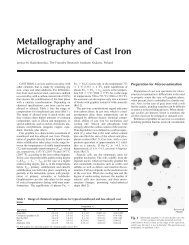Introduction Quantitative X-Ray Diffraction Methods Introduction ...
Introduction Quantitative X-Ray Diffraction Methods Introduction ...
Introduction Quantitative X-Ray Diffraction Methods Introduction ...
Create successful ePaper yourself
Turn your PDF publications into a flip-book with our unique Google optimized e-Paper software.
<strong>Introduction</strong> <strong>Quantitative</strong> X-<strong>Ray</strong> <strong>Diffraction</strong> <strong>Methods</strong><br />
(prepared by James R. Connolly, for EPS400-001, <strong>Introduction</strong> to X-<strong>Ray</strong> Powder <strong>Diffraction</strong>, Spring 2010)<br />
Structure Sensitive Factors: These factors are mostly included in the K (hkl) term in the<br />
intensity equation. Most of these factors are intrinsic properties of the phase producing the<br />
reflection, but their intensity can be modified both temperature and the wavelength of the<br />
incident radiation.<br />
Factor<br />
Parameter<br />
1. Structure-sensitive Atomic scattering factor<br />
Structure factor<br />
Polarization<br />
Multiplicity<br />
Temperature<br />
2. Instrument-sensitive<br />
(a) Absolute intensities<br />
(b) Relative intensities<br />
Source Intensity<br />
Diffractometer efficiency<br />
Voltage drift<br />
Takeoff angle of tube<br />
Receiving slit width<br />
Axial divergence allowed<br />
Divergence slit aperture<br />
Detector dead time<br />
3. Sample-sensitive Microabsorption<br />
Crystallite size<br />
Degree of crystallinity<br />
Residual stress<br />
Degree of particle overlap<br />
Particle orientation<br />
4. Measurement-sensitive Method of peak area measurement<br />
Degree of peak overlap<br />
Method of background subtraction<br />
K 2 stripping or not<br />
Degree of data smoothing employed<br />
Instrument-sensitive Parameters: Variation in power supplied to the X-ray tube can cause<br />
notable variation in incident beam intensity over time. Fortunately most modern digital<br />
power supplies (including our Spellman DF3 unit) include very sophisticated circuitry to<br />
virtually eliminate voltage drift. All X-ray tubes will decrease in intensity as they age,<br />
however, and it is important to monitor this over time.<br />
Detector dead time can cause very intense peaks to be measured with lower intensity; the<br />
proper dead time correction should be applied to correct your data for this.<br />
Sample-sensitive Parameters: These are by far the most important class of factors affecting<br />
quantitative work. All of these factors have the capability of severely compromising the<br />
usefulness of your diffraction data. Bottom line: keep your crystallite size at 1 m for all<br />
(Material in this document is borrowed from many sources; all original material is ©2010 by James R. Connolly)<br />
(Revision date: 6-Apr-10) Page 4 of 14








